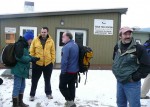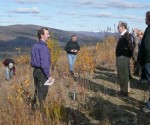September snow blanketed the Arctic tundra as the small plane flew through Anuktuvuk Pass in the Brooks Range, over recent tundra burns and the melting permafrost belowground. Landing on the unsealed airstrip, the eager passengers disembarked, happy to reach solid ground after the delays. They piled into field station vehicles for the final leg and a hot meal at Toolik Field Station, home of the Arctic LTER and proposed National Ecological Observatory Network (NEON) core site. It was the first morning of two successful research visits in September 2008 to LTER-research sites, coinciding with the National Science Board's (NSB) annual retreat in Fairbanks, Alaska. The NSB is the governing body of the National Science Foundation (NSF), one of the federal funding partners on all 26 LTER sites.
On this particular day the scientists had the full attention of the visitors, including six NSF Board members, Deputy Director Kathie Olsen, and Assistant Director for Biological Sciences Jim Collins. The team spent a full day visiting with the scientists and learning about LTER, NEON, and Arctic Observing Network (AON) science.
Two days later the entire NSB and NSF Director Arden Bement visited the Caribou-Poker Creeks Research Watershed site, home of Bonanza Creek LTER and another proposed NEON core site, and nearby Poker Flat Research Range facilities in the boreal forest surrounding Fairbanks. "To have the Board members hear about the science on the ground and straight from the scientists was priceless," said Collins. "Not only did NSF and the NSB benefit but it was a great opportunity for these colleagues to spend valuable time together working on the future of ecological observatory networks and research, which will benefit the biological sciences community for years to come," he added.
Senior scientists and managers from LTER and NEON worked closely with NSF staff in planning and leading both visits to highlight NSF's investments in high-latitude research and global and continental observing systems. NSF's Sonya Mallinoff, an NSB Executive Secretary, lauded the scientists' efforts and their benefits to biological sciences research and infrastructure."The freezing temperatures and logistical considerations were the perfect demonstration of the challenges and costs of conducting research operations in remote areas," said Mallinoff. "This first-hand experience will be close to mind when [Board members get] back in the Board room in D.C. making decisions about issues affecting how we conduct scientific research in this country. Our community will reap the benefits of this in-reach for years to come."
NSF wishes to thank the following people for their generous contributions of time and expertise: Gus Shaver and John Hobbie (The Ecosystems Center, Marine Biological Laboratory, Woods Hole, MA), Dave Schimel and Tony Beasley (NEON, Inc), and Terry Chapin, Jay Jones, Brian Barnes, Syndonia Bret-Harte, Mike Abels, Buck Sharpton, and Roger Smith (University of Alaska, Fairbanks).

 Enlarge this image
Enlarge this image

